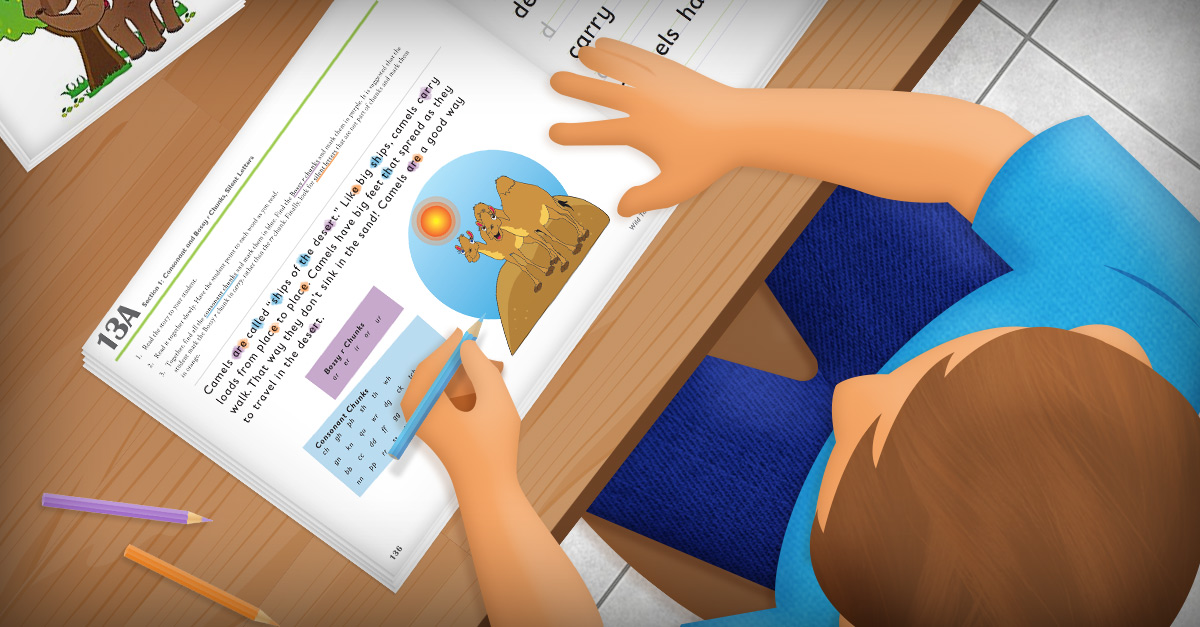The Five Core Activities in Spelling You See

We’ve seen it many times—the quizzical look on a parent’s face when she looks at the Spelling You See program for the first time. Next come the questions, usually prefaced by “If this is a spelling program…”
“Why are there passages to read?”
“Why do I have to read aloud?”
“Why does my child have to write so much?”
I totally understand where the questions are coming from.
Language arts instruction is often confusing because of all the subskills involved; reading, spelling, handwriting, composition, grammar. Some parents choose a separate curriculum for each area, and some go with a more integrated approach. After many years of homeschooling experience and professional research, I can say one thing with confidence: while you may choose to use different materials for reading, spelling, grammar, etc., children learn language in an integrated way. They learn words, and the more familiar they are with words, the more successful they will be in all aspects of their language study. To put it another way, “The more deeply and thoroughly a student knows a word, the more likely he or she is to recognize it, define it, and use it appropriately in speech and writing.” (Source)
For this reason, the Spelling You See program is built on five core activities designed to increase your child’s experience with words. This blog post will discuss these activities briefly and explain how each one contributes to spelling success.
5 Core Activities
Reading
While reading and spelling are different processes, they are also complementary, working together to build a student’s proficiency with language. In the lowest levels of Spelling You See, students use their knowledge of phonics to write words and then read them back, developing fluidity as they move from one skill to the other. In the other levels of the program, students are given short, interesting passages to read, copy, and write from dictation. These passages provide a meaningful context for the words the student will be learning to spell, showing him how they are used in “real life,” instead of presenting them in isolated lists. In Spelling You See, care is taken to make sure the process of reading does not interfere with the student’s focus on spelling. Passages are deliberately written at lower reading levels, and, even then, parents are strongly encouraged to read new passages aloud to students so that they don’t have worry about figuring out words. While you might be tempted to skip the reading portion of a Spelling You See lesson, it’s important to remember that incorporating this core activity helps build language proficiency.
Listening
Listening is another core activity in the Spelling You See program that is often overlooked. For the youngest students in the Phonetic stage of spelling development, much time is spent listening to individual sounds and learning to connect those sounds with letters. In subsequent levels, passages are read aloud so that students hear the correct pronunciations of words and make connections between sounds and letter patterns. Dictation activities in Spelling You See help students practice the skill of transferring sounds that they hear into correctly written words—which is, after all, the fundamental definition of spelling.
Copywork
It may seem meaningless to have students simply copy words, but there is actually great value in this core activity. A 2006 study by Virginia Berninger found that students who wrote words by hand, as opposed to using a keyboard, showed greater brain activity in the areas associated with reading, writing, and working memory—the areas needed to process words. In addition, the physical act of writing stimulates muscle memory, thereby helping students transfer spelling to long-term memory. It’s important to note that correct letter formation should NOT be emphasized during copywork sessions in Spelling You See; that is the goal of handwriting practice, which should be conducted at another time.
Learn more about copywork here <<
Chunking
The term chunking refers to a technique unique to Spelling You See in which students mark recurring letter patterns with assigned colors. This core activity, which appears in the second half of Jack and Jill and beyond, teaches students to pay attention to the individual letters that make up a word, which enhances visual memory of the correct spelling. Parents should understand that chunking should never be associated with phonics “rules”; phonics instruction helps students decode (read) words but is generally unhelpful and even confusing when a student is trying to encode (spell) a word.
Dictation
Dictation is to spelling as a flight simulator is to piloting an aircraft; it’s a controlled way of practicing a skill before launching into real-time, unassisted application. In Spelling You See, the passage the student has been working on all week is read back, one word at a time, and the student writes each word as it is given. During the dictation session, students are given as much assistance as they need; however, in Americana and beyond there is a second dictation, which students are expected to complete independently. As students become more confident spelling words that are familiar to them, their proficiency in spelling gradually increases and becomes incorporated in the writing they do in other subjects and in everyday life.
Learn more about dictation here <<
While each of the five core activities of Spelling You See have value in themselves, when combined they create a powerful mechanism to help students learn to spell correctly. As their skill in spelling improves, their written work communicates ideas more clearly, which in turn increases their confidence. We invite you to explore this exciting program and see what it can do for your student.